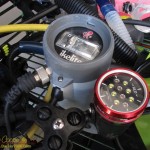Once you descend below a few feet underwater photographs begin to be all greens and blue. The reason is that water absorbs the red light, leaving a very skewed color balance in the images. Thus bringing a light source with you becomes important to allow the underwater world to be seen in vivid color.

Enter the Sola Photo 800 by Light and Motion… The Sola offers a nice flood with an even field of illumination for video. Several of my dive buddies use Sola lights, Thus I have had a chance to check out the lights firsthand before putting down a few hundred dollars. I was particularly noting the build quality and the control setup, both are excellent. With dozens of dives on the lights they still work well. Perhaps I should consider one of these little units?
There are several models available, but it is the photo version I was looking at. The light provides 800 lumens of white in an evenly illuminated, large field. The photo version also offers a red mode for framing and focusing that purportedly does not change the behavior of the subject. Deep red light is not seen by many marine critters as there is little to no red light at depth to be seen.
A coincidence of decent sales on the Sola lights occurring on my birthday resulted in a package appearing on my lanai. I ordered light with both the hand grip mount and with a ball mount that will allow attachment to my camera rigs.
My GoPro is equipped with a flip down red filter to help restore color balance in the red depleted conditions underwater. Would the red filter be useful in conjunction with the light? Would using both be counterproductive? Another thought was to use the red mode of the light to add the missing red light to the imagery without using the filter.
First up was to try the red light mode on open coral reef. How would throwing some red light into the mix work in the red starved conditions at 40ft depth? The answer… Interesting. The red light does restore some reds to the scene, certain fish become much more colorful, coralline algae and sponge covered rock reveal their vivid red colors that are hidden without the light. Photographically it does not work… Anything shadowed becomes a vivid red that is totally unnatural in appearance.
For the second dive of the day I swapped the new light onto my Canon G12 setup. This by means of a three way joint from Ultralight that allows two lights to be mounted on the end of an arm. This puts the Sola right beside the usual Ikelight strobe.
A shallow cave with a school of squirrelfish offered a chance to test the red light mode. Will the fish react to the red light? Squirrelfish, soldierfish, and bigeyes are night foragers that shelter in caves and overhangs during the day. These fish are photophobic, shying away from bright dive lights. While there was some reaction to the red light, it was nothing like what you normally see with these fish. The fish did retreat from the red light, but the reaction was modest. Switching to white light elicited the normal response, the entire school quickly retreating to the far recesses of the cave. I should have filmed that! An encouraging result that will require further testing. I expect this red mode to be most useful in caves and on night dives.
The best answer… Use the light in addition to the red filter for open reef shots. The light illuminates the nearby fish while the red filter works to restore a little balance to the more distant objects. If you have complete control over the light, in a cave or deep overhang, just go with the light only, flipping the filter out of the way.
After two nearly 90 minute dives of steady use the light was nearing the end of its charge. I would put the runtime at nearly two hours, but I was constantly fiddling with the light through that time and it is hard to judge. I would expect to get one good solid night dive out of the light, or several dives of intermittent use.
My overall impression of the light? Pretty good! Small, nice charging system, good battery life, simple controls that can be used in gloves. The quality of the light is pretty nice too, just what I need. The utility of the red mode remains to be proven, but I will have ample opportunity to try in future dives.


happy belated Birthday Andrew
Aloha
Also consider the Intova Galaxy. 2500 lumens in similar form factor and more endurance.